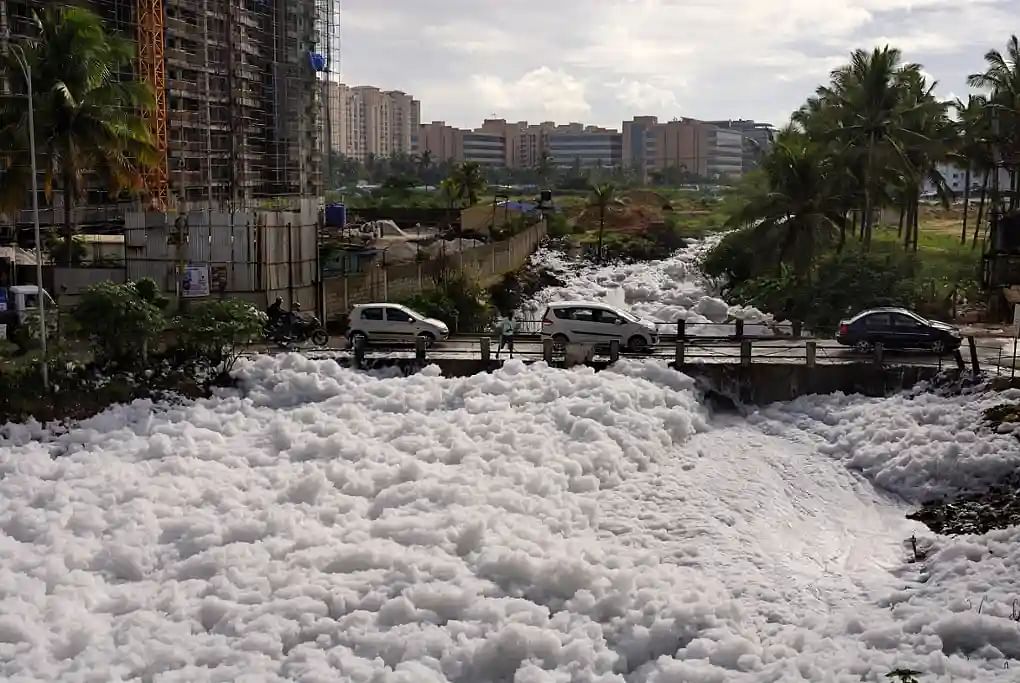Eshwar Khandre, the newly appointed Minister of Forest, Ecology, and Environment conducted a visit to assess the progress and announced the restoration will be completed by December 2024.
Approximately 50 per cent of the desilting work has been successfully accomplished.
The Bangalore Development Authority (BDA) started the restoration work of Bellandur in December 2020.
The restoration of the Bellandur lake, which is one of the largest in the city, will be completed by December 2024, announced Eshwar Khandre, the newly appointed Minister of Forest, Ecology, and Environment yesterday, following his visit to the lake.
The minister conducted a visit to assess the ongoing progress on the restoration along with officials representing the Karnataka State Pollution Control Board (KSPCB).
He said that work is happening in full swing on the 14 Sewage Treatment Plants (STP), which are needed to keep the sewage water from flowing into the lake, as per The Hindu.
The Minister stated “The restoration work of the lake was delayed due to some practical problems, mainly the inflow of sewage water. Around 550 Minimum Liquid Discharge (MLD) sewage water comes into that lake, according to experts. The STPs are expected to solve these issues. The work is going on the upgrade of five old STPs and the setting up of nine new ones. The officials have assured that the work will be completed by December 2024”.
Furthermore, he mentioned that approximately 50 per cent of the desilting work has been successfully accomplished.
However, a major challenge arises from the lack of available dumping sites for the accumulated silt as there is strong opposition from local residents residing near quarries.
“There were lakhs of tonnes of silt in the lake, and while half of the silt which was removed from the lake has been shifted, the rest remains there. I have instructed the officials to make arrangements for the disposal soon,” the minister said.
Bellandur Lake Pollution
Known for its high levels of pollution, the alarming condition of the lake hit national and international headlines after it caught fire in 2015 and 2017.
The lake which once served as a source for drinking water, irrigation and supported numerous fishing families, became a dumping site for untreated sewage, discharged directly through various inlets connected to the lake.
These inlets also carried industrial effluents and sludge from different parts of the city, resulting in the formation of froth in the lake.
During rainfall, the lake experiences frothing, where foam accumulates on the surface and reaches heights, even covering roads and bridges due to the presence of huge amounts of industrial waste.

(Source: Debashish Ghosh/ The Guardian)
The froth that forms on the lake carried a pungent smell and poses a risk of skin irritation and diseases, as reported.
Further, the rising froth covering the roads caused significant inconvenience for two-wheelers and residents in the surrounding settlements, hindering vehicular movement.
For several years, the deteriorating condition of the lake has drawn considerable attention from Bengaluru citizens and those connected to the lake.
Once A City Of A Thousand Lakes
The National Green Tribunal (NGT) had previously issued directives for the immediate closure and ban on dumping of municipal solid waste in the vicinity of the lake, accompanied by the imposition of fines.
The minister, during his visit, highlighted a lapse on the part of the department regarding the collection of fines from over 400 industries situated in the lake’s catchment area.
“The industries there have not built STPs and taking up suo moto case, the NGT has penalised them up to Rs 198 crore. However, only Rs 5 crore has been collected from the department so far. The reason for this would be found out and strict action will be taken against those who have failed to recover the fines,” Khandre said.
The Bangalore Development Authority (BDA) started the restoration work of Bellandur in December 2020 and as per the initial plan, the rejuvenation work was to be over by August 2022.
Under the project, nearly 916 acres of area is being excavated and over 32 lakh cubic meters of silt is required to be removed.
The project was taken up at a total cost of Rs 100.3 crore.
In the past, Bengaluru was renowned as the “city of a thousand lakes,” but today, only a handful of these lakes remain active.
For several years, the waterbodies in the city have been continuously deteriorating, raising significant concerns regarding water quality, waste management, and the overall ecological balance of the city.
Due to the absence of nearby rivers to facilitate water movement and waste disposal, the lakes have become isolated systems.
Previously, these interconnected lake systems served as a dependable water source.
However, current reports indicate that merely 17 lakes remain in operation, marking a decline from the 51 healthy lakes recorded in 1985.


